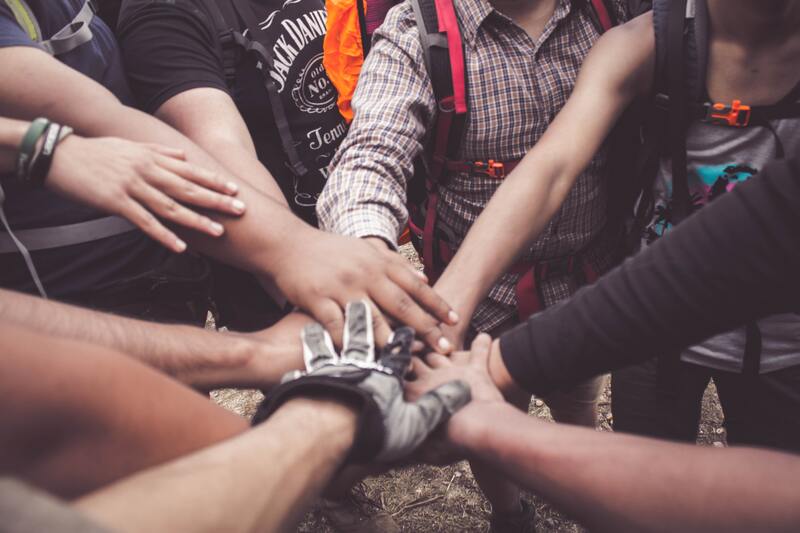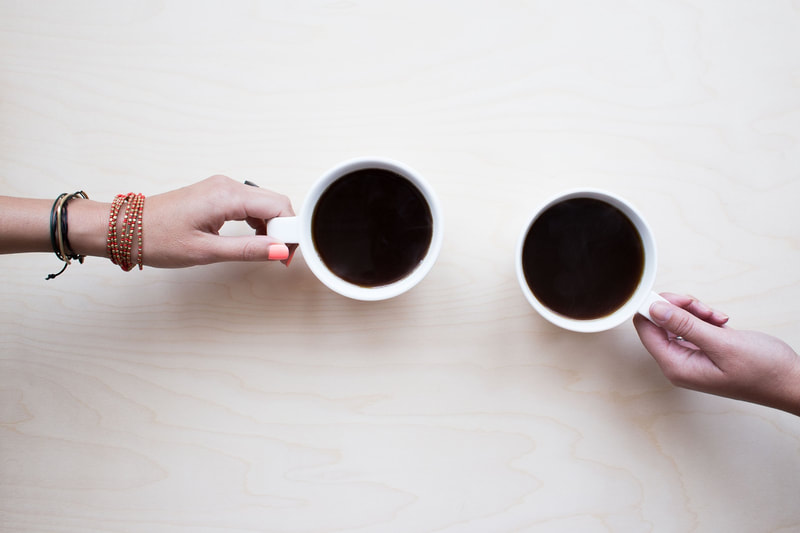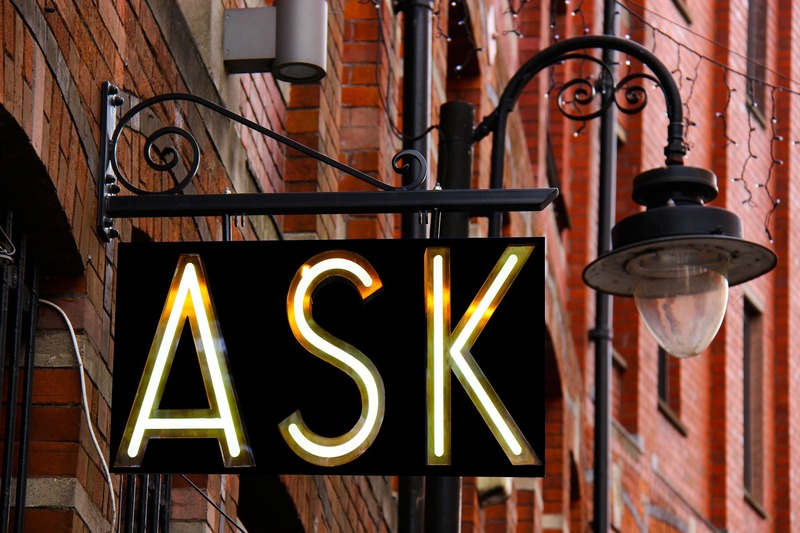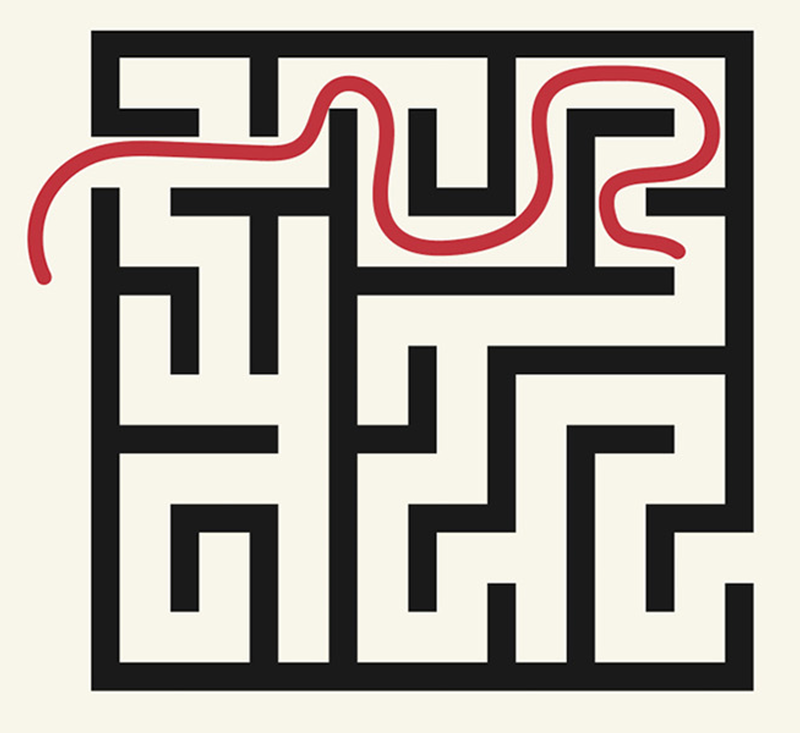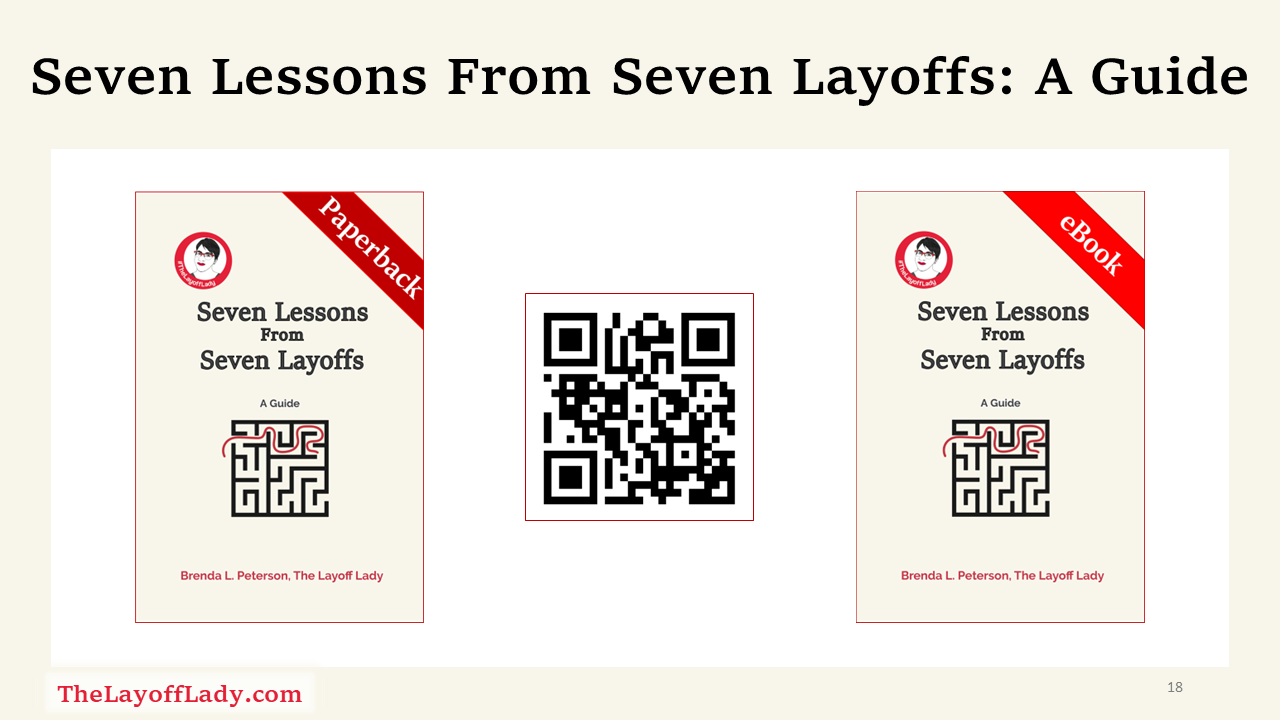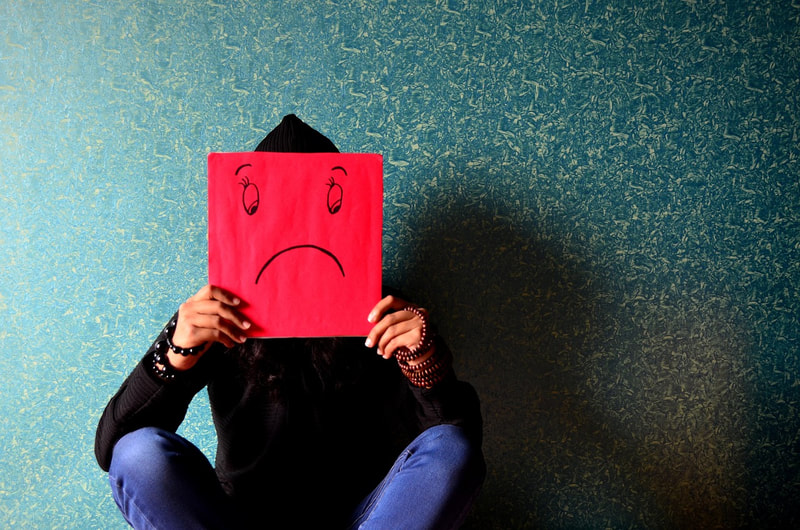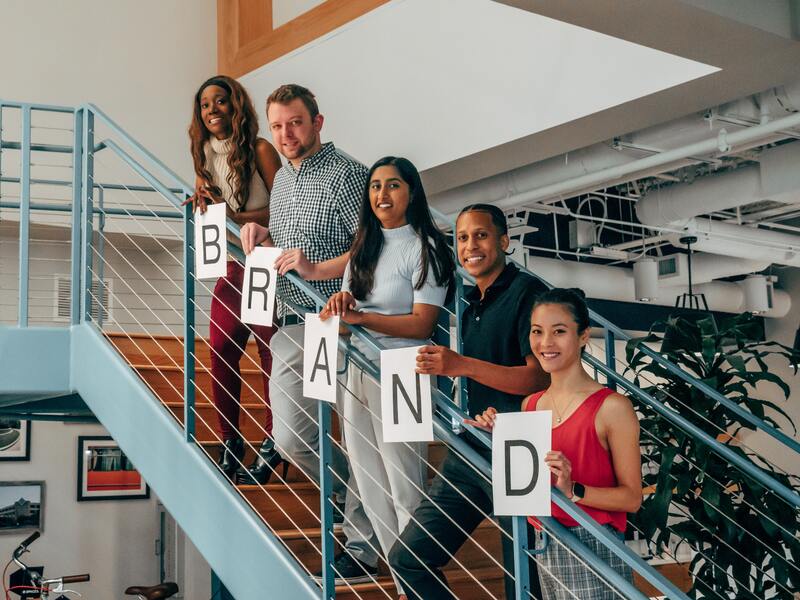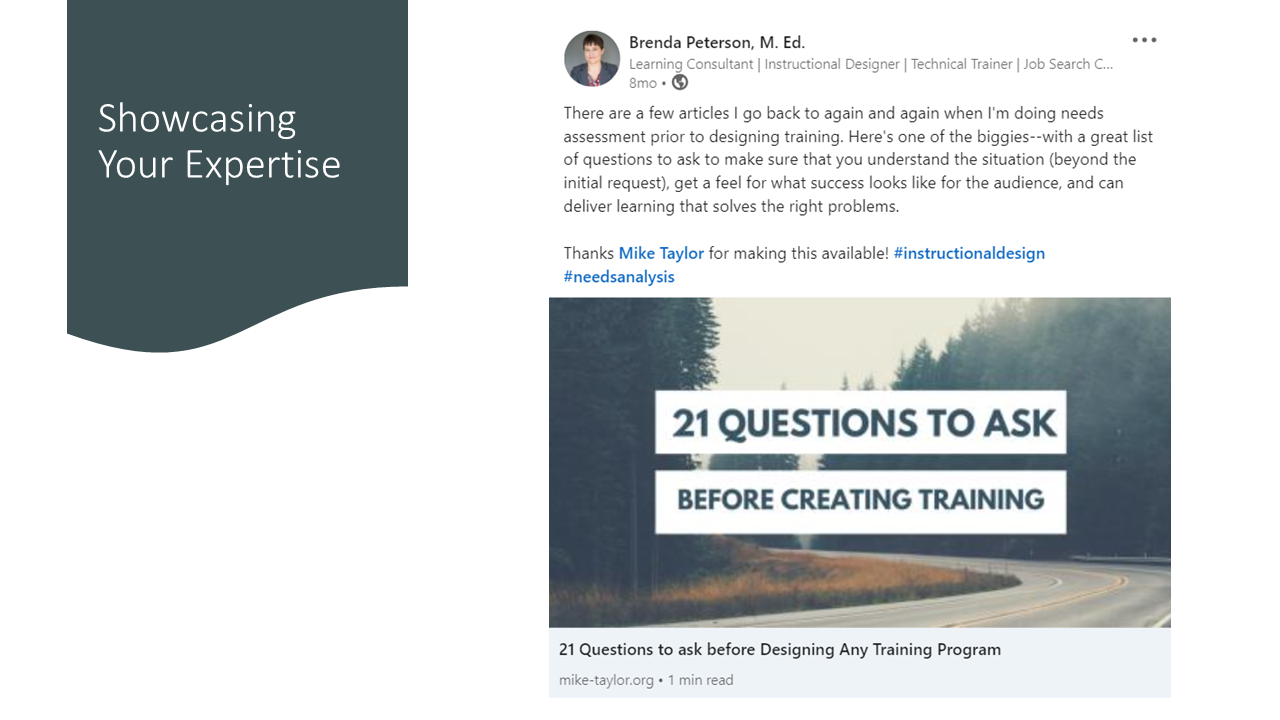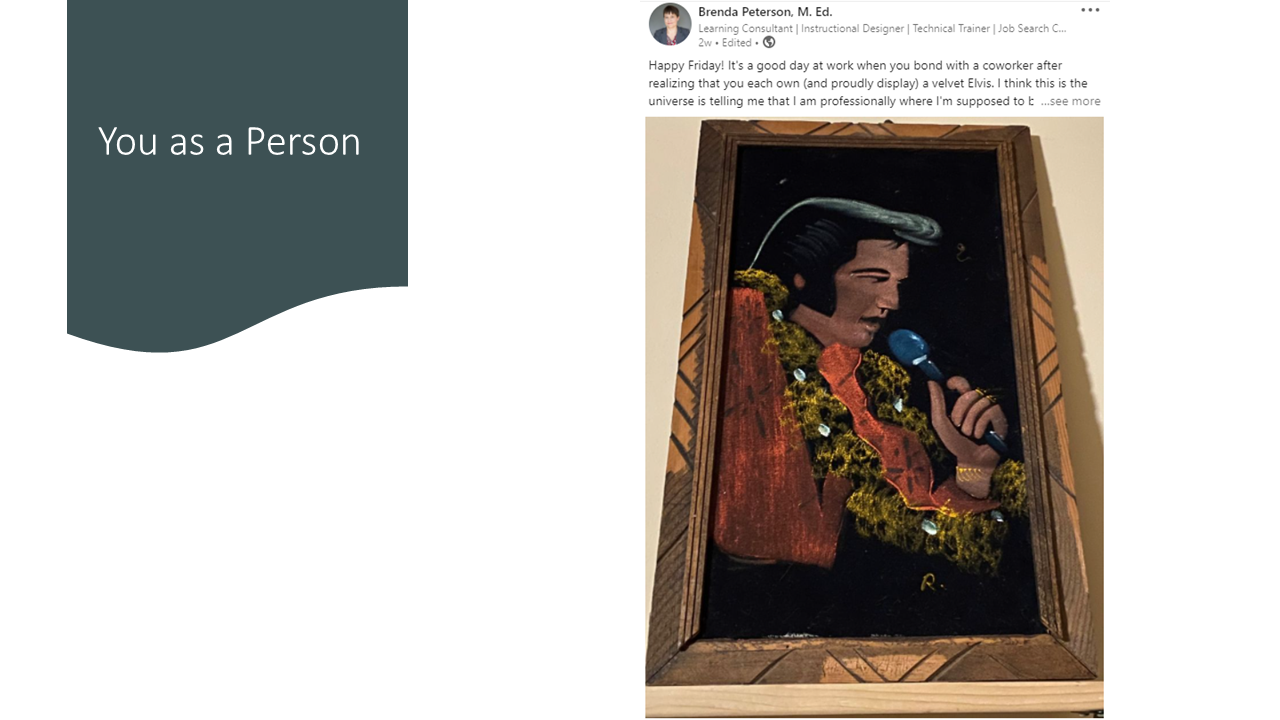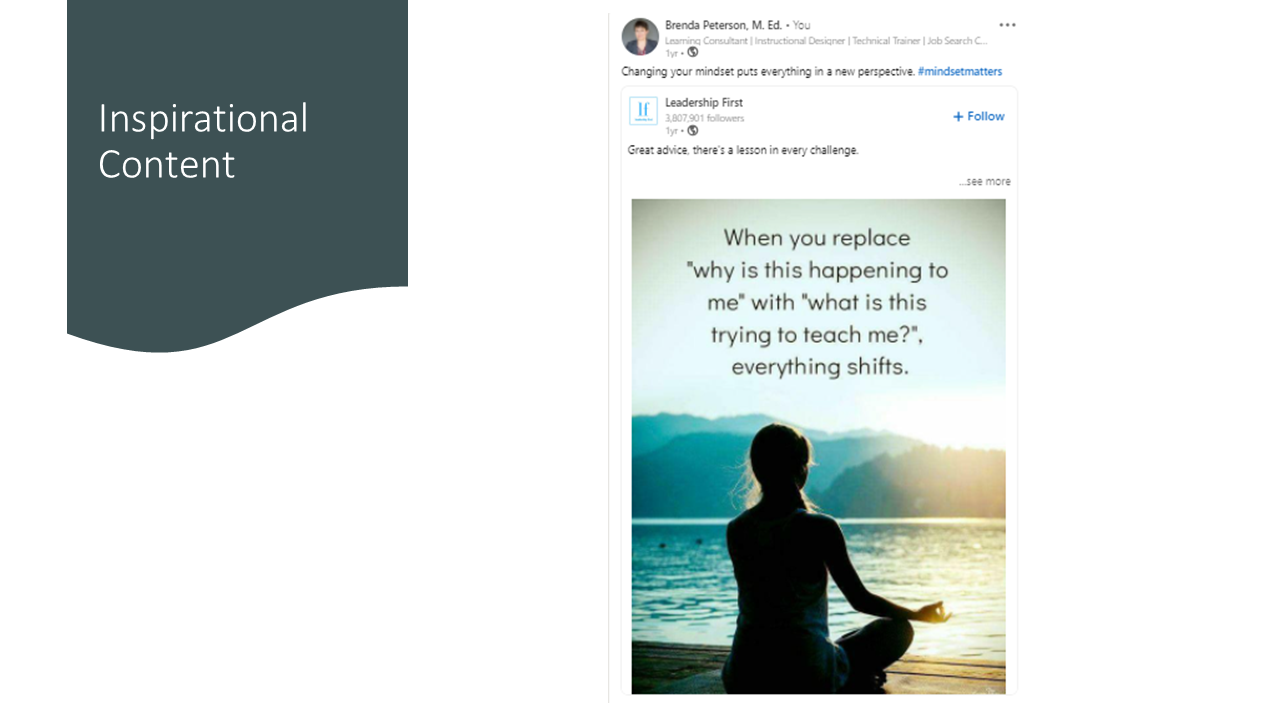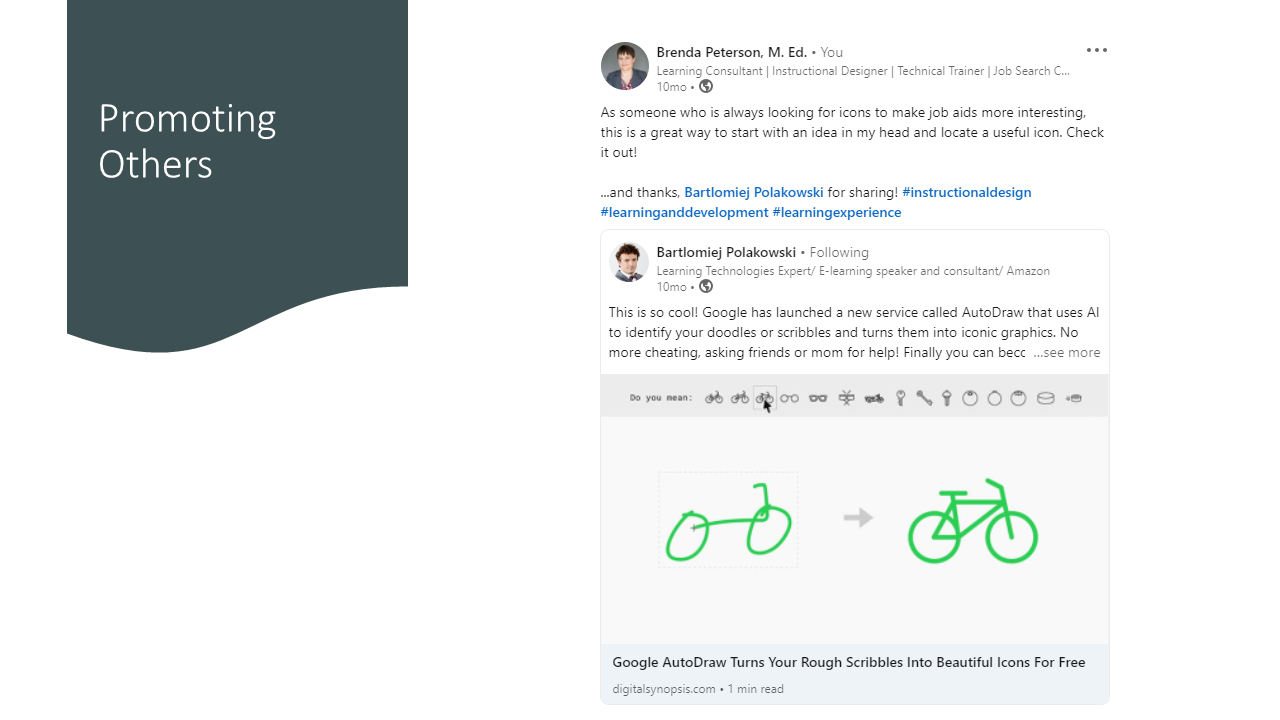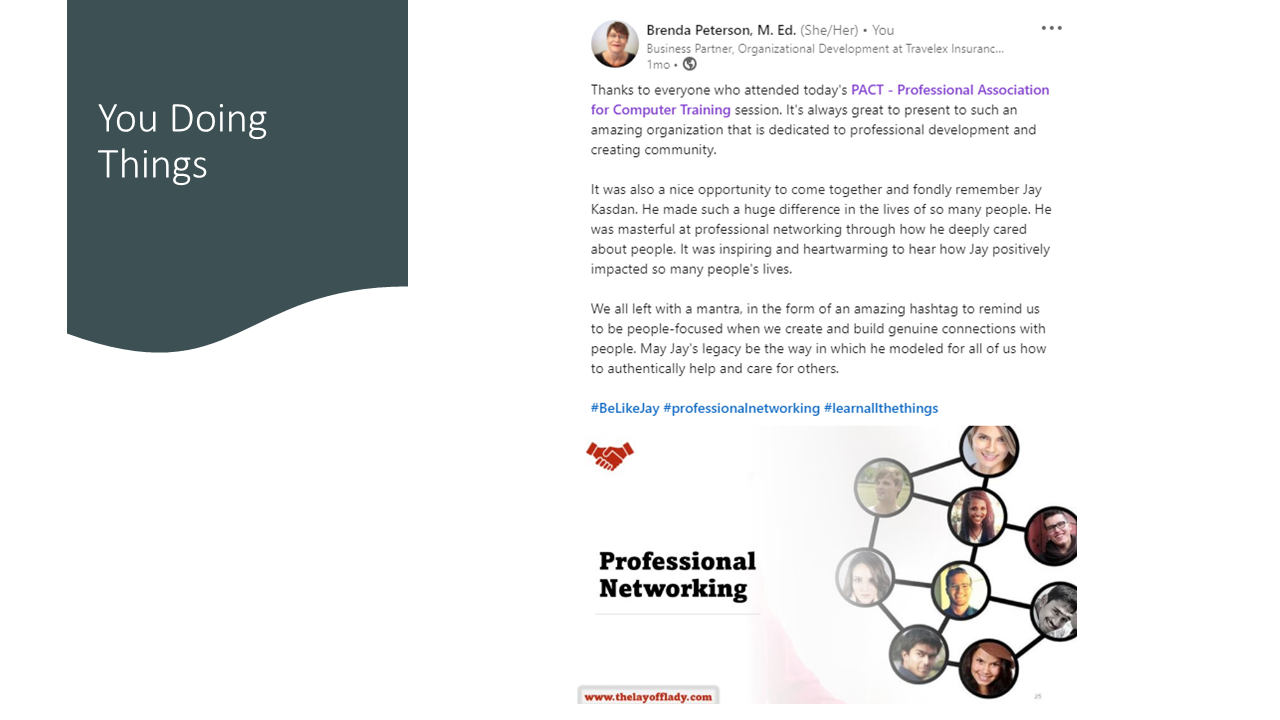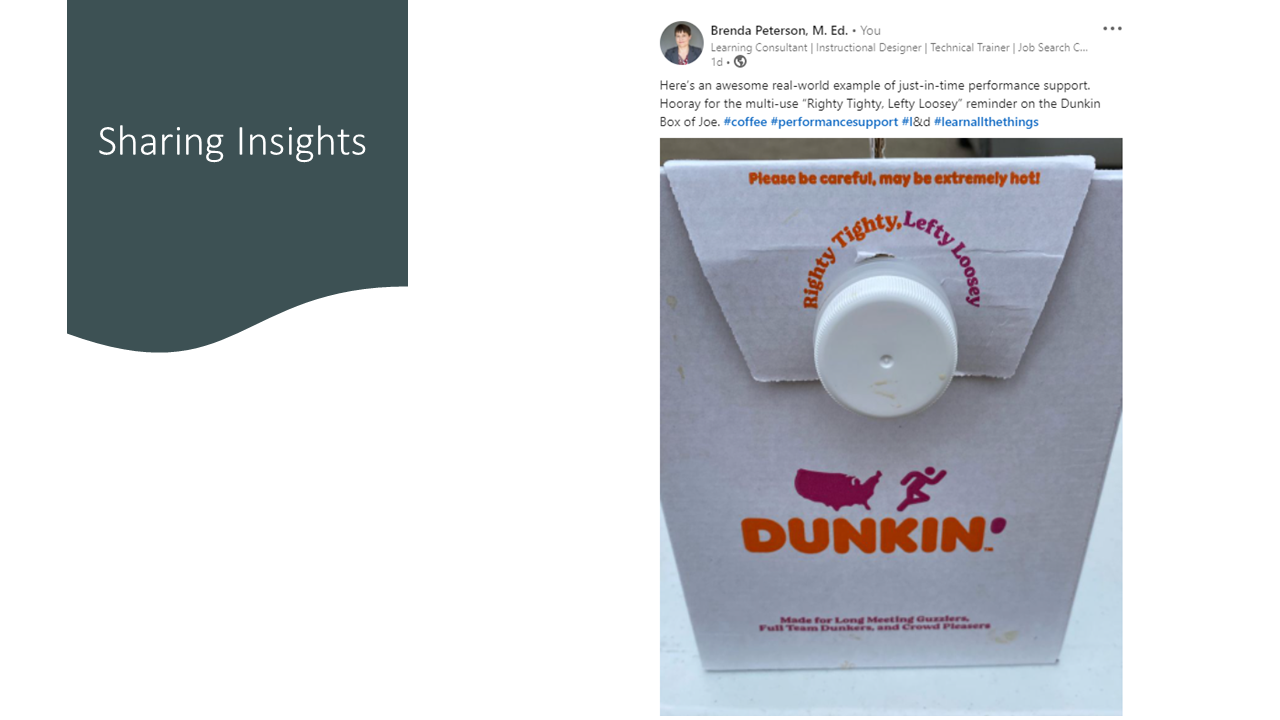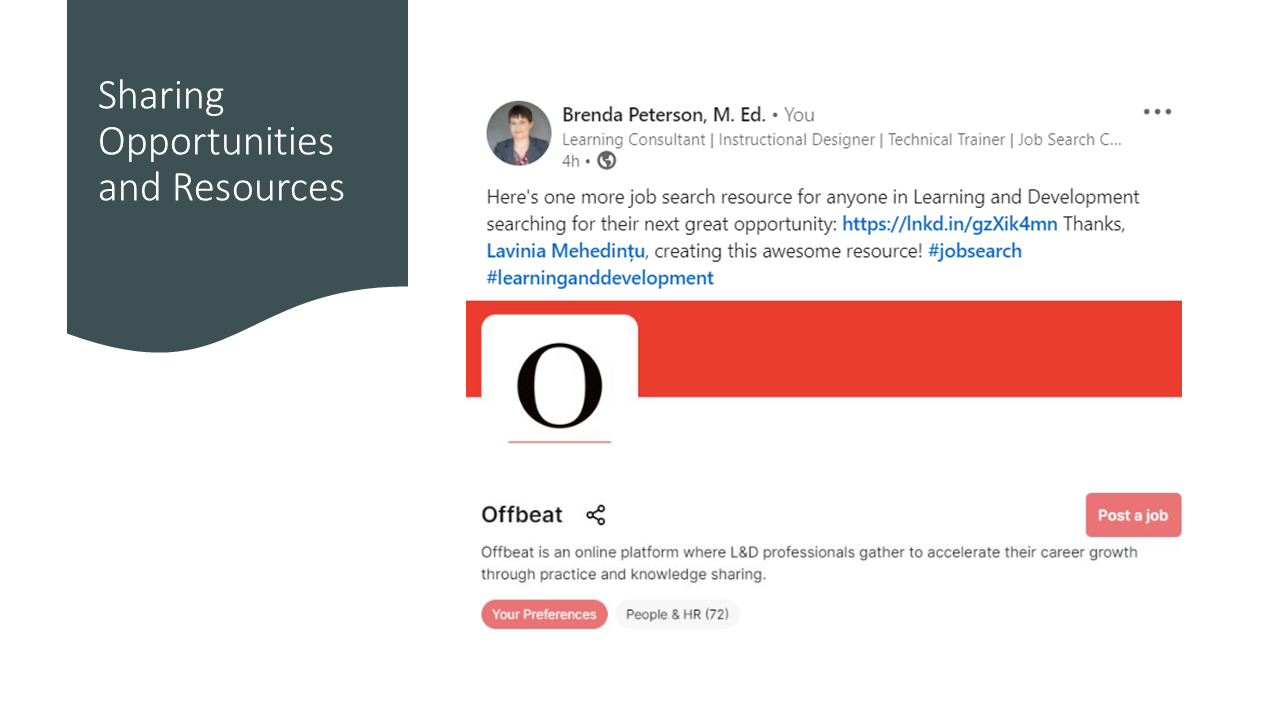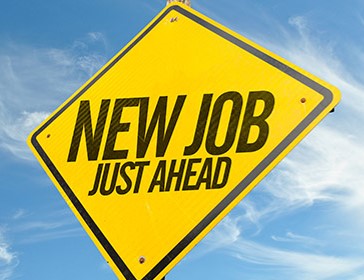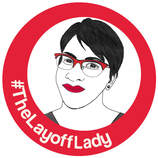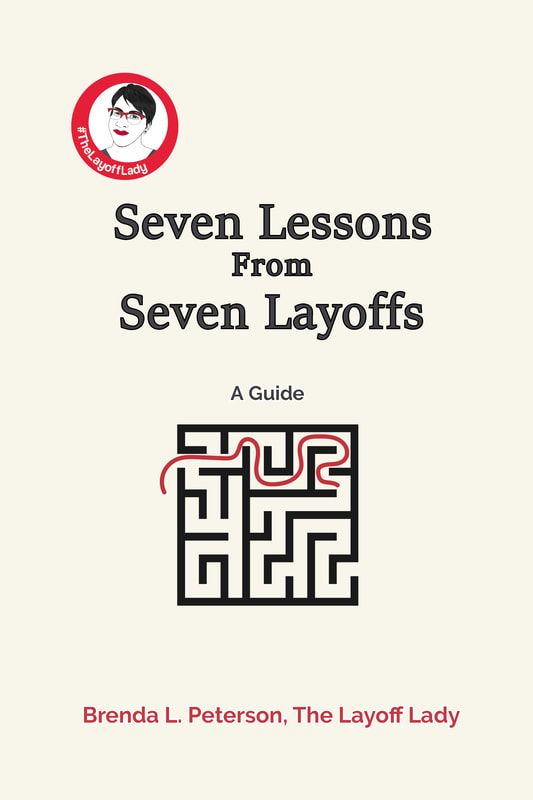|
By Brenda L. Peterson, The Layoff Lady Don't Go It AloneLife is challenging when nothing in particular is happening. When you're going through a job change (especially one you didn't plan), it's even harder. While I'm a fan of self-reliance, I also know the value of finding people who want to support you and letting them do it. You're not weak for needing people. You are smart for planning ahead for what you will need. You Need Help Because This is HardI have been through a post-layoff job transition 7 times, and it is difficult each and every time. There is the fear that it will just never end, and you'll be drifting for eternity trying to find paid work where you can pay your bills--much less in a job you want. You worry that you'll have to settle for something that may be even worse than the worst job you've ever had. You also worry that you'll run out of money and not be able to pay your bills and lose everything you own and everyone you've ever loved. While your rational mind knows this is all pretty unlikely, there will be moments when everything seems hopeless. That's where your support network comes in. No matter how resilient and downright badass you are, doing this alone makes it way harder. People Want to Help You: Make Sure to Let ThemAs an extra added bonus, people want to help you! I'm always inspired by people who come out of the woodwork to check on me, tell me about an open position, thank me for helping them once upon a time, or offer to refer me for a role. Everyone has struggled with something at one time or another, and someone has helped them. Let other people help you. Building Your TeamIt also takes a village to get you through a career transition. Relying on one person for everything is all kinds of stressful. Know that people want to help, and it's a matter of figuring out what you need, letting people know, and reaching out to people when needed. Going through a job search is challenging, even in the best of circumstances. It can be even more challenging if you're starting from a layoff (especially the part where someone else got to make a big, uninvited life decision for you). Types of Help You NeedHere's a starter list of the types of help you may need during your job transition. More specifically, here is some of what I needed. Use this as a starting point and add details as it helps you:
Who Can HelpWhen it comes to help, I start with my inner circle--close friends and family. I'm also sure to widen my support team beyond them, too. I also move beyond that immediate group. I interact with my LinkedIn connections. I tap into online groups including job search groups, The White Box Club, and even LinkedIn groups focusing on networking or a content area (like sales enablement). I interact with in-person membership groups like ATD or the Omaha OD Network. Or I seek out non-work connections through social Meetup groups or activities. Sometimes, I just spend time in coffee shops to indirectly interact with other people. It's a matter of figuring out what you need and finding a person to help. Asking for HelpKnow, too, that there will be times when you need to straight up reach out to someone because you need help. Each person will have their areas of interest and expertise, so be sure to keep that in mind when asking for help. It's helpful to consider who you might contact for different needs. Here are a few cases where I reached out to different people to ask for help:
Learn More
0 Comments
by Brenda L. Peterson, The Layoff Lady Network Building in the BeforetimesPre-pandemic, "networking" typically meant attending in-person events, shaking a few hands, and having a somewhat meaningful conversation with another human. While in-person opportunities are again plentiful, webinars continue to be popular since they are a flexible way to bring people together to learn. Be sure to think of your network during virtual events, too. Connect with Webinar AttendeesLike many people, I have attended (and delivered) approximately a bijillion online meetings, trainings, and interactive instructor-led sessions. I've been approaching these sessions with a mind towards not just attending, but also making new connections. Although the process differs from in-person interaction with people, I have managed to connect with more people (and often form more meaningful connections) than attending in-person meetings and “working the room.” As someone who runs introverted and communicates effectively in writing, this was an opportunity to turn webinars into a bonus network-building exercise. Your Personal Webinar BrandingWhen attending a webinar, I make sure that people are able to see who I am, my full name, and a picture, if at all possible. I use the same photo I use on LinkedIn so that people associate me with that picture. I also make sure that my first and last name are present so people have a chance of being able to find me after the session--or will recognize my name. In addition, during the webinar, I interact during the session. This usually involves commenting in the chat when prompted--which is also an opportunity for other attendees to see my full name. During any small group interactions, I'm sure to turn my camera on so people can see my face, hear my voice, and see my name. If the presenter asks people to share out loud, I usually turn on my camera, and share my thoughts. Again, this is another opportunity for people to hear my voice, see my face, and see my name. Each of these "impressions" helps people start to get to know me at least a little bit. Finding Potential ConnectionsDuring a webinar, I often take a screenshot of the participant list and a gallery of attendees if people are on camera. Whenever possible, download the chat from the session. This helps me identify who was active in the webinar and gives me additional information on anything they might have shared during the session. I often make notes on notecards during sessions to help me remember who might have said what and key content covered. All of these details can help me when interacting with attendees later on when I send LinkedIn connection requests. Researching Potential ConnectionsAfter attending a webinar, here is my process for adding new LinkedIn connections:
One Option: Personalizing a Connection RequestPersonalizing connection requests is a great way to start building a relationship with a new professional contact. Here are the key components I include:
Personalized Connection Request ExamplesHere are a few examples of messages that you can use to invite people to connect. Currently, LinkedIn allows you to include up to 300 characters when personalizing connection requests. Hi, Jen. I see we both attended today’s White Box Club meeting. I’m also in career transition and seeking a new role in learning and development. Let's connect! I'm also always up for a 30-minute "virtual coffee" meeting to discuss how we can help one another as we job search. --Brenda Hi, Jack. Great to interact with you a bit at this morning's Excellence Share. I love sharing ideas with fellow L&D professionals. Let's connect! --Brenda Hi, Javier. I see we both attended today's "Sales Enablement Best Practices" webinar. I definitely enjoy learning from this group. Since you mentioned that you are job searching, be sure to check out The White Box Club on Meetup to help you as you find your next role. Let's connect! --Brenda Other Options: Showing Your Value as a ConnectionNow that LinkedIn limits the number of personalized connection requests those with the basic membership receive each month, sending personalized connection requests might not be an option for you. In those cases, here are a few other options for helping to show your value to a potential connection:
After The Initial ConnectionHow do you further nurture that relationship? Here are a few ideas.
Continue to Build The RelationshipAfter connecting with people initially, be sure to continue to nurture those connections. Posting useful content, and occasionally messaging people is one way to do that. Ideally, you can add value to the relationship before you are in a position where you need to ask those individuals for help. Learn MoreBy Brenda L. Peterson, The Layoff Lady The Value of Professional NetworkingWhen it comes to job searching, professional networking is a critical component of success. Ideally, you make initial connections with people through LinkedIn (maybe even after meeting them in person or at an online group event). While this is a great start, there is value in building relationships beyond that initial connection. A 1:1 meeting can significantly strengthen a networking relationship and help you learn how you and your new connection can help one another succeed. About 1:1 Networking MeetingsSo what exactly is a networking meeting? Back in the day, I remember hearing people talk about doing "informational interviews." In short, if you were interested in having a particular job or working with a specific company, you would contact an organization or individual and ask if they would meet you for an informational interview. In this 1:1 meeting, which could take place via phone or in person, you might learn about the company, what they are looking for, skills to acquire, and more. It also allowed you to start to build a relationship with a company--or a possible advocate in the person doling out said information. Fast forward to now. Today, a networking meeting is typically between you and another person deciding to spend a half hour-ish together. This meeting, sometimes called a coffee chat, could happen virtually via Zoom or in person, often over coffee. If you're job searching, the typical focus will be on how to progress in your job search. Someone may agree to a networking meeting because you have things in common (like a field of work, background, professional goals), because they are generally committed to helping people when they are job searching, or because you have a mutual acquaintance to ask that person to meet with you to help you out. Networking Meeting = Informal InterviewWhenever you have an opportunity to meet one-on-one with someone, remember that you are taking part in a type of informal interview. Whenever I meet with someone in career transition, my goal is to help them figure out their next steps, offer advice (if they ask and are interested), and give them ideas on further steps they might take, including who they should speak with next While I go in with this idea, the amount of help I'll provide also depends on how this networking meeting goes. Ideally, we have a good, productive conversation, and I think to myself, "I totally want to help this person more." If the meeting goes well, I'll refer them to specific resources that might benefit them (like a networking group they might want to join, a company to check out, someone to follow on LinkedIn) and even put in a good word for them to have a networking meeting with someone else who might get them closer to their goals. In addition, if it goes REALLY well, this is a person who I'll refer to others for openings, pass on job opportunities, and maybe even hire someday. If the meeting doesn't go well, I'll share a few resources, but I may not be willing to help them as actively moving forward. Remember, any interaction you have with people will impact their desire to help you in the future. Types of Networking MeetingsHere are a few common types of networking meetings:
Networking Meeting Best PracticesHere are a few best practices for networking meetings:
The True Power of Networking MeetingsWhen people talk about how they "networked" into a new job, typically, that means they leveraged their initial connections to help make inroads with new contacts, who helped them get closer to a new position. The holy grail of networking meetings is when the person you meet with agrees to introduce you to someone else they know who could help you. That process repeats until you're talking to a hiring manager or influencer who can help you get an interview for a job. Having good networking meetings is a critical step in that process. Learn MoreBy Brenda L. Peterson, The Layoff Lady Getting To Know Your LinkedIn ConnectionsConnecting with someone on LinkedIn is a great way to start a formalized relationship with someone in your professional network. While that is a great start, deepening those relationships is a helpful next step to get more value out of LinkedIn. Let's look at a few ways to do just that. Interacting with PostsInteracting with posts on LinkedIn is a great way to continue to build relationships with your connections and demonstrate your professional value. Not only is this a great way to build your credibility with many connections at the same time, it also gives you an opportunity to showcase your knowledge without having to choose the initial content for the post. You can also use your comments to interact with others and even use this as a starting point to invite other commenters to connect. Adding Your ReactionThe easiest way to interact is by adding a reaction to a post. With a click of a button, you can like a post or select from the other available responses. When you react to a post, your name will be listed on the post as well. This is an easy way to have people see your name and affiliate it with the content you liked. Adding your reaction also helps more people see the original post. Commenting on a PostAn even more valuable way to interact with a post is by commenting. Once you have connected with someone, reading and commenting on their posts is an excellent way to build on that relationship. This way, they are starting the conversation, and you are helping expand on that content by adding your ideas. In addition, you can comment on other people's comments and share additional value. You can thank the initial poster for sharing the idea, add your thoughts, share your experiences, and illustrate how you have used the concept in practice. Commenting on posts also gives you an inroad to connect with someone else who is also interacting with that post. Commenting is a great way to interact with others in your profession, build credibility, and make more meaningful connections. It also helps to achieve one of your LinkedIn goals of showcasing your knowledge and also sharing valuable information. RepostingIf someone posts something of value to your connections, you may want to comment on the post itself and then consider reposting it with your comments. When you repost content, first, you'll see anything you typed, then LinkedIn will include the entire original post. This helps the original post get additional views and also enables you to share useful content with your network. When I repost content, I usually include "Thanks [original poster] for sharing this information!" To include the original poster's name, include the @, then type the first part of their name, and choose their name from the options provided. (This is often called an "at mention." This will tag them in the post so they can interact with your new post, which will help boost the number of people who see the post. Sharing Your Own LinkedIn PostsSharing content on LinkedIn is a great way to engage with your connections, add value to your professional relationships, and promote who you are and what you know. Unfortunately, very few people ever post anything at all--which is a huge missed opportunity to differentiate yourself from others in your field. Another question that comes up is the frequency of posting. I recommend posting on LinkedIn no more than once a day and posting one to four times per week. Use your favorite search engine for recommendations on the best times and days of the week to post to get the most views on your posts. As for content, you don't have to write a lengthy, original manifesto to post on LinkedIn and make an impact. Personally, most of the content I share on LinkedIn includes some version of the following:
Once you make a post, be sure to like any comments other people make on your post and even reply to each comment. The more likes and comments you receive on your post, the more people will see it. This will continue to build your professional brand and add value to the networking relationships you are fostering through LinkedIn. Learn More
By Brenda L. Peterson, The Layoff Lady About Personal BrandingWhether you're actively job searching or just trying to build your professional network, sharing content on social media is a great way to demonstrate your value. By identifying topics that people with your professional focus care about and sharing related content, you will help people associate your name with those areas of expertise. While regularly sharing content is valuable, it can also be time-consuming. Here are three tools I regularly use to organize and streamline this process. Google AlertsOn LinkedIn, you will share some content that you directly create. This might include a post about an event you attended, your career news, or your observations on a given topic. When it comes to LinkedIn, most of my content includes articles on critical topics of interest, with some introductory commentary framing the value I see in the article. This means I need to locate and collect those articles to post them as needed. One way I locate helpful content on each topic is to set up a Google Alert for keywords or phrases relevant to my professional skill set. Each Google Alert sends you an email with new online content regularly. Here are a few examples of what Google Alerts you may want to set up:
After you identify the keywords for topics that people in your industry talk about, create alerts to keep a steady stream of content coming to you. Flipboard serves two essential purposes. First, you can follow exciting topics and see content other users share. Second, you can use Flipboard to create magazines on a given subject area and bookmark content that interests you for later use. Here are a few ways you might find content to save in a Flipboard magazine:
Gathering possible information to post when you run across it, organizing it, and making it easy to access will save you a lot of time figuring out what to post. BufferWhile the other two tools are about finding and organizing possible content to post, now let's look at a tool to schedule those posts. There are several tools available to help you manage social media posts. Currently, I use Buffer. This online platform has a free version that will enable you to manage posting on up to three social media platforms. When my goal is building my professional network and job searching, I focus on LinkedIn. Buffer enables you to create, schedule, and update posts as needed. When searching for a new role, I may post as often as daily. When focusing on building or maintaining my network, I may post once or twice a week. The Learn More section includes recommendations on how often and at what times you may want to share content for the greatest impact. Creating A Post When I create a post to share an article, I often include the following details:
Here are a few examples:
Learn MoreBy Brenda L. Peterson, The Layoff Lady Messaging With Your ConnectionsOne of the benefits of having connections on LinkedIn is that you can directly send them messages without having a paid subscription. However, this feature has also been used poorly on several occasions. Let's look at how to use LinkedIn messaging effectively to continue building professional relationships and provide some guidelines for how to use this feature well. The Value of Mutually Beneficial RelationshipsTo have a valuable professional newtork, make sure those relationships are mutually beneficial. Networking is about give and take. Make sure that you are adding value along the way. This includes sharing useful content, congratulating people on their accomplishments, and answering one-off questions when people ask for advice. In short, be a good LinkedIn neighbor. If you give more than you take, your LinkedIn connections will be more likely to help you when you need it. Messages That Add ValueWhen directly contacting your LinkedIn connections, make sure you are not overfocused on asking for favors. It is important to provide value first. Here are a few types of messages that give more than they take:
Make sure you are not THAT PERSON who only reaches out when they need a favor. Direct Asks For Help: Worst PracticesAsking for help is an art. First, you need to be willing to ask for help. Next, you need to craft your ask in a way that you have a higher likelihood of getting that help. Here are a few significant issues I’ve seen from people attempting to ask for job search help:
The Worst AsksHere are a three questions that may not get you much of a response:
Why are these not good asks? For one, these are big requests that require a lot of effort to do well. For example:
Direct Asks For Help: Better PracticesHere are a few better asks, but may only work with connections who you know very well and who you have helped in the past:
These requests are specific, which is better, but each is still a sizeable request. The first two may be time intensive. The next two involve your connection putting their reputation on the line to recommend you for a role. The final one requires a block of time on your connection's calendar. Depending on our interactions prior to these requests, their response may vary from “of course!” to no response at all. Again, remember to make sure your asks are aligned with how well you know one another. Direct Asks for Help: Best PracticesAsks are better when they are more specific and less time intensive. It’s also helpful if there is context. Here are a few asks that are more likely to get responses. The requests earlier in this list are more likely to get a response.
People Get To Say NoRemember, when you are asking for help, people will tell you no. More likely than telling you a direct no, they may just not respond. Ever. Keep in mind that job searching, like sales, means that you're going to hear a whole lot of no on the way to that one yes you need. When you need a specific thing, it's useful to ask multiple people for help to give you a better chance of getting a response. It's also not personal. We're each on LinkedIn using it to varying degrees and all trying to accomplish our own goals. Making sure that you are making the relationships mutually beneficial will make it much more likely that people will respond to you and want to lend you a hand when you need it. Learn More
By Brenda L. Peterson, The Layoff Lady About The Seven Layoff LessonsThrough my seven layoffs and many conversations with others in post-layoff career transition, I have learned seven core lessons:
About Layoff Lesson Five: Help People Help YouLife is challenging when nothing out-of-the-ordinary is happening. It's even harder when you're going through an unexpected job change. While I'm a fan of self-reliance, I also know how important it is to find your people and support one another as you go through challenges. You're not weak for needing people. You are strong because you know the value of building and leveraging relationships to help get you through trying times. I have found that people genuinely want to help. In many cases, though, they might not know what you need. Not only is it vital that you seek out help when you need it, but you need to figure out what type of help you need. One Career Transition RevelationHere's something that might surprise you. When you tell people that you're looking for a new job, this is when you will discover that many people don’t know exactly what it is you do for a living. Instead of being taken aback that they don’t know, use this as an opportunity to learn how to tell them what you want and need during your career transition--and it's much more than just a new paying job. Figure Out What Life Help You NeedFirst off, you need to figure the types of life help you might need:
Figure Out What Job Search Help You NeedIn addition, you need to figure the types of job search help you might need:
It Takes a VillageOnce you have a better idea of what you need, make sure you don't expect one person to fill all of these roles. Think about who could help you in each area and reach out to them. Leveraging Your Professional NetworkLinkedIn is my goto tool for building and managing my professional network. It's importan to make sure your LinkedIn profile represents you well, and that you showcase your experience and the value you bring to others, and to a new role. There is also an art (and a process) to asking people in your professional network in a way that is mutually beneficial. For The Whole StoryFor all the information on each of the seven lessons pick up a copy of my book Seven Lessons From Seven Layoffs: A Guide. Learn MoreBy Brenda L. Peterson, The Layoff Lady Managing Job AnxietyRecently, I was at a professional development event where we shared best practices for delivering effective virtual training sessions. During networking time, I talked with a woman who had been laid off, and then called back to work for the same company (which is rare for someone working in the field of learning and development). While she was glad to be employed again, she was having a hard time being happy in her new/old position without constantly worrying about her job unexpectedly ending again. To Worry, or Not To Worry?When you've been laid off before, or just seen people around you lose their jobs, it's hard not to worry about it happening to you. Whenever you read about layoffs in the news, hear that your company's sales numbers were lower than expected, or hear rumors about a company merger, your mind might jump to conclusions. Instead of letting a wave of panic run through you each time your boss invites you to meet one-on-one, there is an alternative: changing your overall mindset. My Old Operating Modes: Either/OrEarlier in my career, I had two operating modes when it came to work: “I’m happy with my job” and “I need to find a new job right this minute.” When I was happy with my job, I did excellent work at my day job and didn't worry much about the future beyond that role. I would learn new skills for the job, but I didn't always think about my overall career trajectory. Conversely, when I knew I needed to launch a job search, I shifted away from the work I was doing and started focusing solely on taking my next steps outside of my current role and organization. Only then did I shift to developing skills applicable to another workplace, meeting more people to help me get a new job, and planning to exit the organization. My New Mindset: Both/AndI finally realized I didn't have to pick between these two operating modes. Instead, I needed to shift my overall way of thinking and adopt the both/and mindset that was also more long-term and sustainable. I started focusing on myself as a working professional and what I needed to do to succeed personally, regardless of who my specific employer was. This included focusing on my ongoing learning and development, building my professional network, and planning for contingencies. This built up my career resilience, which helped me feel more confident that I would thrive regardless of my current work situation. Learning and DevelopmentWhen people think of learning, they often focus on formal degrees, certifications, and completion certificates from instructor-led classes. While these are valuable, and often a great foundation, ongoing learning can take many forms. Whether you attend a webinar, watch a TedTalk, read an article online, or listen to podcasts on your area of interest, you are continuing your professional development. Staying current with industry trends and continuing to learn and grow helps me perform well in my current role while also allowing me to be future ready. In an ever-changing world, continued professional growth is the best way to manage whatever happens next. Building My Professional NetworkToo often, networking is depicted as a superficial act that involves making initial connections with people, then dreading the next day’s “Would you like to buy something from me” calls. I approach networking differently. My goal is to build mutually beneficial relationships with people. Interacting with these connections provides opportunities to share information, learn from one another, and help one another out along the way. I use LinkedIn to track my professional network. I connect with people I've met before and with whom I share something in common. My LinkedIn network includes former coworkers, individuals I've sat next to at in-person events, people I've attended an online event with, and professionals working in the same field as me. Contingency PlanningRegardless of my role, and even if it seems to be going well, I always have a backup plan, a backup backup plan, and then a couple more backup plans after those. After weathering many layoffs and the unique challenges of each, I have a broad sense of the situations I may need to mitigate. Those include an unexpected job loss, choosing an interim health care option, and how to launch a post-layoff job search. Here are a few steps I have taken to help prepare for possible situations:
What Do You Think?How do you help yourself not worry about being laid off? Share your thoughts in the comments. Learn More
By Brenda L. Peterson, The Layoff Lady Using LinkedIn To Build Your BrandSharing content on LinkedIn is a great way to engage with your connections, add value to your professional relationships, and promote who you are and what you know. However, only about 1% of LinkedIn users ever post anything at all--which I think is a huge missed opportunity to stand out. Why People Don't Post on LinkedInWhen I've asked people what is stopping them from posting on LinkedIn, the overwhelming answer is, "I don't know what to post." Like with most everything in life, it comes down to your overall goals. Whether I'm promoting myself in general or actively searching for a new "day job" in L&D, my goals remain consistent: to share knowledge and strengthen relationships. There are many ways posting on LinkedIn can help. I suggest using LinkedIn to share posts that support who you are as a professional. Types of PostsYou don't have to write a long, original manifesto to post on LinkedIn and make an impact. Here are examples of what you can post on LinkedIn that will help you "build your brand" and share what you're all about, both professionally and as a person:
Let's look at a few examples of my posts. Showcasing Your ExpertiseWho are you professionally? What are your skills? What do you bring to the table as a possible employee of a given company? For me, my skills include training leadership, needs assessment, relationship building, instructional design, project management, technical writing, facilitating classes, and more. You as a PersonWho are you? What is it like to work with you? What are your interests? What do you care about? For me, I love helping people to succeed. I love removing obstacles so people can be successful. I enjoy board games, inline skating, my cats, my family, and a good cup of coffee. I am also kind of a nerd. I also own a velvet Elvis--because of course I do. Inspirational ContentWhat picks you up when you are down? What insights struck you? What motivates you? For me, I love quotes about the value of lifelong learning, self care, and shifting your mindset. Promoting OthersWho inspires you? Who do you learn from? Who shared a useful resource that benefitted you? For me, I enjoy finding awesome people to learn from and sharing useful articles with others who might also find them helpful. You Doing ThingsWhat do you do? What did you write? How do you volunteer? For me, I lead classes, go to professional development meetings, deliver webinars, inline skate, and, on rare occasion, beat my now-adult child at a board game. Your Work SamplesWhat projects do you work on? What do you write? What content to you create? What experiences have you learned from? For me, I teach custom webinars, write blog articles, assist other instructors, and design learning. Sharing InsightsWhat have you learned about your chosen profession? What's a tip you like to share? What's your go-to strategy for solving a problem? What's something unique you have noticed? For me, I make observations, see unique solutions to common problems, or see how training and learning are out there in the world. And also coffee. Sharing Opportunities and ResourcesWhat problems can you help people solve? Who do you know who is a go to person for a given topic? What is a solution you learned about from a common problem? For me, I share information for people who want to get into corporate training, share job search resources, point people towards others who share topic-specific content. Learn More
By Brenda L. Peterson, The Layoff Lady I Found a Job!After 9 months of career transition, I am gainfully employed again! I'm excited to be working in an amazing organizational development role. Each layoff and subsequent job search brings its own challenges. Take a look at my lessons learned from this time around. New Challenges
My Post-Layoff Transitions: DurationPeople often ask how long a career transition lasts. To give a partial answer to that question, here is my unscientific, skewed-sample-size data on how long each of my periods of post-layoff career transition have lasted. The time listed starts with my last day of work with my previous employer (aka "Layoff Day") and ends with my first workday in a new role:
Overall, my average time in career transition is 128 days (just over 4 months). Layoff #7 was the longest one I've had so far, and 3 months longer than my previous record. Career Transition Duration: Contributing FactorsThere are a few key factors that made this period of career transition longer than after my previous layoffs:
The Numbers: Job Applications and InterviewsGiven that my previous employer was starting to make organizational changes, including a few rounds of "quiet layoffs," I started to keep an eye out for a new job starting in July of 2022, which I've included in this summary:
The Insights: More Opportunities, Fewer InterviewsOne challenge during this job search is the newly added focus on work location--specifically the following labels: onsite, hybrid, and remote. Part of why I felt comfortable relocating from Minneapolis, MN to Omaha, NE in mid-2022 was the prevalence of remote work. I also realized that the definition of "remote" for companies can vary widely. As I reflect on my job search, I wonder how many positions I applied for with companies who were not interested in or able to hire someone who lives in my current state of residence. While there are, indeed, many remote jobs available in my chosen field of learning and development, I discovered first-hand that companies and job search sites are not necessarily aligned on what each of these words means. Remote jobs mean more applications for me and way more competition:
The Numbers: Working With RecruitersRemember, LinkedIn is your billboard to the world. Be sure to make your profile a good representation of what you bring to the table as a job candidate. Have a strong headline that includes the job title(s) that interest you and a few key skills. Have your professional summary in the About section, your work experiences, and at least a couple of sentences about each of your previous jobs. This is what recruiters will check after you apply. This is what may come up in a recruiter's search when they are sourcing candidates. Make this count. Here are the responses from recruiters this time around:
My Re-Launched Job SearchIn April, when I re-launched my job search, I changed my overall approach.
At this point in my job search, I had also built stronger relationships with my colleagues in my Omaha-area professional development groups. When I first launched my job search in the fall, I had only been in the area for 2 months. Between then and April, I had met more people in person, talked with them in meetings, presented to groups, and helped a few of them solve business problems. I'm sure getting to know me better and working alongside me helped them to feel more comfortable speaking to my skillset and recommending me as my job search progressed. My Overall Insights
Learn More
|

Just get laid off?
Click here for info on what to do first. Author7-time layoff survivor Brenda L. Peterson, The Layoff Lady, waxes poetic on layoffs, job transitions, & career resilience. Buy The Book!Were you recently laid off from your job and need a roadmap for what's next? Pick up a copy of my book, Seven Lessons From Seven Layoffs: A Guide!
Categories
All
Archives
July 2024
|

